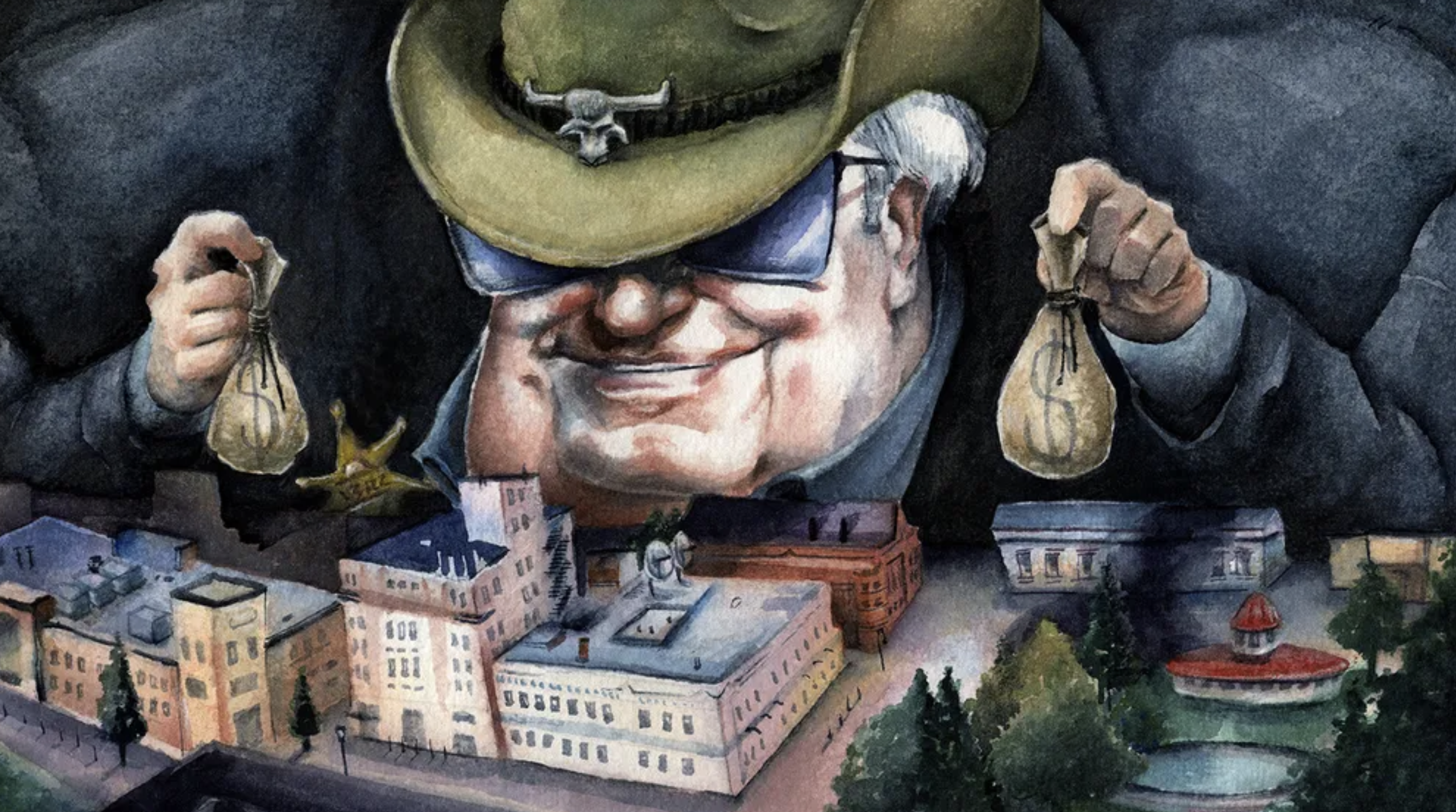Private donors including big-box stores, fossil fuel companies, and tech giants are secretly giving hundreds of millions of dollars annually to law enforcement agencies and related foundations, allowing police to buy specialized weapons and technology with little public oversight.
Experts say this huge deluge of police “dark money” funding, detailed in a new University of Chicago working paper and in an additional analysis shared exclusively with The Lever, leaves law enforcement beholden to the companies and powerful donors bankrolling them, rather than the communities that officers are sworn to serve.
“The big-picture finding is that the world of private donations to police is a lot bigger and more complex than previously estimated,” said Robert Vargas, a professor of sociology at the University of Chicago and a co-author of the study.
The study, which analyzed a database of nonprofit tax returns, found that from 2014 to 2019, more than 600 private donors and organizations collectively funneled $461 million to police and to other nonprofits supporting police — a figure that, Vargas said, was “without a doubt an undercount,” as it was based on organizations’ own disclosures about their giving.
The private money comes in part from big retailers like Target and Walmart; oil companies like Chevron and Shell; and Microsoft and other Big Tech players — companies that have touted their support of law enforcement for years.

American Oligarchy
How Warren Buffett’s billionaire son, Howard Buffett, took over a U.S. city and made it his personal playground.
The new research exposes how easily private donors can secretly funnel money to police. Anonymous donors use asset managers like Fidelity Investments to fund the litany of police foundations and other opaque nonprofit organizations that support police work, the researchers found. The clandestine funds have made Fidelity’s charitable arm one of the largest private donors to police in the country.
In many jurisdictions, private funding for police comes with virtually no oversight, and can be used to buy surveillance technology, high-tech weapons, and other items that agencies might otherwise struggle to justify.
For instance, the Baltimore Police Department for years used private money to fund a secret aerial surveillance program that could track the locations of people throughout the city in real time. Billionaire philanthropists in Texas provided money for the program, but routed the funds through a nonprofit in Baltimore, which allowed the program to stay, for a time, out of the public eye. When news of the program became public, it caused an outcry, and was eventually ruled unconstitutional in court.
In Los Angeles, the city’s police department used money from Target — also routed through a local police foundation — to purchase software from Palantir, venture capitalist Peter Thiel’s data analytics company, that provides police massive amounts of sensitive data and purports to identify crime “hot spots.”
In Philadelphia, privately funded police nonprofits have purchased ballistic helmets, drones, motorcycles, and even horses for the city’s police department.
Such surveillance technology and military gear is deployed disproportionately in Black communities and low-income neighborhoods. The heightened surveillance intensifies local policing, which research has shown can harm community health and well-being.
Private funding represents a tiny fraction of the money that states and cities spend on police, which by some estimates amounts to more than $100 billion annually.
“In comparison to their municipal budgets, it seems like a drop in the bucket,” said Gin Armstrong, the executive director of LittleSis, a group that researches corporate power and influence.
But the money has an outsized impact, Armstrong argued.
“It’s really important to look at how this [private] money is being spent,” she said. “Most of the money in municipal budgets is going to salaries and benefits. This is going to equipment and experimental technology, and it’s all outside of public discussion, and often even outside of public reporting.” It was, Armstrong continued, a “huge slush fund that is completely unaccountable.”
“Now we have a sense of just how big that slush fund is,” she said.
“A Kind Of Shell Corporation”
One of the most common ways that private donations, whether from oil companies, billionaires, or big-box retailers, make their way to law enforcement is through police foundations, nonprofits established to support law enforcement in a particular city, such as the New York City Police Foundation and the Los Angeles Police Foundation.
According to public data from the city of New York, the New York City Police Department reported $30 million in private donations from 2019 to 2022, of which $26.8 million — nearly 90 percent — came from the New York City Police Foundation.
Police foundations position themselves as charities, soliciting donations and then providing that money to local law enforcement. Their supporters say that the work can improve officer morale, and that the additional funding can supplement strained public budgets — although municipal police tend to be flush with public resources.

Wear Your Support
Check out The Lever’s merch. Every purchase supports holding the powerful accountable through the tireless independent journalism that corporate media will not do.
“I refer to [police foundations] as a kind of shell corporation,” said Kevin Walby, an associate professor of criminal justice at the University of Winnipeg who studies police foundations in the United States and Canada. “They can move money around in ways that public bodies can’t. They don’t really have robust reporting or disclosure mechanisms.” The term “dark money,” he said, was an appropriate way to describe their support.
Police foundations, like most charities, do not have to publicly report their donors. Until an exposé from The Intercept, for instance, the New York City Police Foundation did not disclose that it received a $1 million donation from the United Arab Emirates in 2012, even when that money was passed directly along to the police to support “criminal investigations” in the city.
There are some 250 police foundations in the U.S., of which nearly 80 percent say that they fund technology and equipment for police, as well as programming for officers and public relations campaigns. While such organizations have been around for decades, Walby said they have grown steadily since the 1990s, particularly in response to calls to limit the ever-increasing public funding for police, which has nearly tripled over the last several decades. Research has documented increasing revenues for police foundations year after year.
“A big period of growth happened after 2020,” Walby said, adding that it was in “direct response” to the protests over the murder of George Floyd in May of that year. “They were using corporate money as a kind of backstop to buttress themselves against the defund [the police] movement.”
The corporate bankrollers of police foundations often appear to get a good return on their investments. Target, for instance, has long funded surveillance and anti-crime programs in cities across the country, successfully promoting crackdowns on retail theft and petty crime in disinvested neighborhoods over other, arguably more pressing, community concerns.
In St. Louis, the city’s police chief receives $100,000 a year directly from the local police foundation in addition to his salary, an arrangement that critics say has ensured that the department is beholden to local business interests.
“No Paper Trail”
Previous research has shown that police foundations receive tens of millions of dollars annually from private donors. But the new research by Vargas and his co-authors shows that such local foundations are in fact part of a far broader network of nonprofits and funds dedicated to funneling private money and in-kind gifts to police — one that involves hundreds of millions of dollars.
The new study identified hundreds of dark-money organizations that finance police departments — sometimes donating directly to law enforcement, and sometimes donating to other police nonprofits, creating a tangled web of donors and intermediaries.
Collectively, those organizations gave more than $826 million in donations over a six-year period, and reported revenues of more than $16 billion, according to additional analysis that the researchers shared with The Lever.

Hold Them Accountable With A Donation
Give a one-time donation in any amount to fund The Lever‘s mission to hold the powerful accountable through reader-supported investigative journalism. Every cent helps.
The organizations include associations of sheriffs and police chiefs, national nonprofits like the police charity 100 Club, and private foundations like that of wealthy police advocate Howard Buffett, the son of billionaire Warren Buffett. Furthermore, the researchers found, some police foundations — like those in New York City, St. Louis, and San Diego — donated not only to the police agency in their own city, but to other law enforcement agencies around the country.
“This is an important set of findings because it reveals in real terms the amount of capital that is flowing, and it reveals the number of corporate nodes in the network,” Walby said.
Financial services companies like Fidelity Investments and Charles Schwab also appear in the data as some of the biggest donors to police dark-money groups. Both companies allow wealthy individuals to funnel money to nonprofits through “donor-advised funds,” charitable investment accounts that are an increasingly popular way to anonymize donations and get a tax break at the same time. Various police foundations have begun advertising this funding arrangement as one way to donate.
“The truth is that if somebody wanted to donate a lot of money and hide their tracks, all they would do is make a donation to a police nonprofit from a donor-advised fund, and then there’s essentially no paper trail,” Vargas said.
While critics have pushed for additional transparency and regulation around donor-advised funds, describing them as an unaccountable form of billionaire philanthropy, federal regulators have appeared hesitant to launch a major crackdown. Last November, the Internal Revenue Service proposed some modest limitations on their use to rein in spending on lobbying and other noncharitable causes — and police charities are among the entities that have opposed the new rules.
Police foundations and other private donors have also found ways to limit disclosure about the gifts they provide to police, the researchers found. When the researchers looked at Chicago as a case study, they found that 90 percent of private donations to police went unreported, revealing, they wrote, “police finance organizations’ interest in keeping their funding of police secret.”
A Push For Accountability
For the most part, the millions in dark-money funding that police agencies receive each year is perfectly legal — presenting a challenge for those who want to see greater transparency.
“There are largely no laws or policies governing foundation donations to the police,” said Evan Feeney, the deputy senior campaign director at Color of Change, an advocacy group that has opposed corporate backing of police.
The foundations have thus created a kind of loophole, one that “legally allows officers and departments to take gifts from vendors, sidestepping conflict of interest and donor disclosure rules,” Feeney said. Palantir, for instance, has donated to police foundations that subsequently funded law enforcement purchases of Palantir’s own data analytics technology.
Even in places that require official city approval of gifts from foundations, like Los Angeles, such a process has often appeared to be a formality, with gifts being rubber-stamped by local officials over the opposition of local communities and activists.
“Cities must end these untraceable donations and require that any equipment, device, technology, or software that is purchased or donated through a police foundation is subject to disclosure, oversight, and accountability laws,” Feeney said.
There has been some movement on the issue. In January, New York City enacted a law, with the grudging support of the local police, that will require the police department to provide an annual report on how it spends the millions in private donations that it receives, both from the foundation and other sources. Unlike its use of public dollars, the department has not previously been required to disclose how it uses private funding.
The law also requires the New York Police Department to provide information on its private donors. But because many of these donations are routed through the New York City Police Foundation, the donors will likely still remain anonymous.




